Alone in a New World With Vast Open Space, and Sheep

“
At Pitchstone Waters, our goat herders are seasonal workers from Peru.
NOTE: this article was originally published to NYTimes.com on September 23, 2022. It was written by Miriam Jordan.
Latin American sheepherders, here on work visas, do the same nomadic work that European immigrants did before them. But do they have a shot at the American dream?

A herd of sheep grazing in the San Juan Mountains of western Colorado.
Credit…William Woody for The New York Times
ENGINEER PASS, Colo. — The baas, bleats and bells were fading ever so slightly, and the shepherd’s trained ear detected that his flock was veering off the path home, for this was the soundtrack of his life in the Rocky Mountains. “The sheep must be herded,” he said in Spanish, as he quickly ascended a hill overlooking a meadow.
Then the herder, Ricardo Mendoza, whistled loudly, commanding his two dogs to coax his 1,700 sheep closer to his campito, a tiny shed with a single sun-bleached word — “HOME” — over the door. His employer had hauled it up a winding, unpaved road used by 19th-century miners to this 13,000-foot pass shortly before Mr. Mendoza arrived with his horse, pack mule, dogs and sheep, ready to settle into the last outpost of his seasonal nomadic journey, about 65 miles north of Durango in western Colorado.
Mr. Mendoza, 46, has spent most of the past decade living in these rugged, remote mountains, herding sheep raised for wool and meat from spring to fall. “You live in complete solitude, just you, your animals and your thoughts,” he said, gazing at the windswept tundra below the soaring Uncompahgre and Wetterhorn peaks.
He is among some 2,000 herders, most of them from Peru, whom the American sheep industry depends on, brought to the United States on temporary visas designated for people who do grueling agricultural work that many Americans shun.
In the high deserts and mountains of the West, men like Mr. Mendoza dwell in tents and tiny campers for months on end, without running water, toilets or other basic conveniences. They often follow their flocks’ peregrinations on foot, like previous generations of immigrant sheepherders, performing a job that has endured since biblical times.
“Sheepherding really hasn’t changed. Nothing has really changed about it,” said Dominic Inda, Mr. Mendoza’s boss, whose father and two uncles came to Colorado from Spain in the early 1960s to herd sheep.

Ricardo Mendoza monitoring his flock, with his herding dogs, who he considers his family. “I talk to them as if they were people, and they listen,” he said. “They know me better than anyone. They know my secrets.”
Credit…William Woody for The New York Times
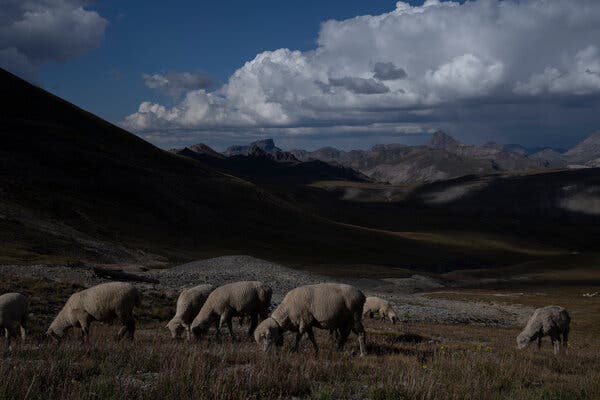
Mr. Mendoza tends to more than 1,000 heads of sheep.
William Woody for The New York Times
The herders in most states make $1,807.23 a month, the minimum salary stipulated by the Labor Department based on a 48-hour workweek.
In June, an advocacy group filed a lawsuit in federal court in Nevada against the Western Range Association, accusing its rancher members of colluding to suppress sheepherders’ wages by coordinating to pay them “at or near” the legal minimum. The association, which brings workers on the H-2A visas for ranches in 13 states, has asked the court to dismiss the case.
Mr. Mendoza said he made $2,231 a month.
“Here there is no day off, no weekend, no leisure time,” said Mr. Mendoza, who wore a green turtleneck sweater and worker overalls under an oversize camouflage coat on a recent late summer day, when the temperature changed at the blink of the sun. “I’m on call 24 hours a day. You have to protect the sheep all the time.”
The docile creatures are easy prey for predators. The sheepherder keeps a .30-06 rifle that he has used to finish off eight bears and at least as many coyotes, he said.
“I might not see the sheep, but I am paying close attention,” he said, the fedora over his wool cap lending him a regal air.
The last time Mr. Mendoza spent time with his family, as allowed by his visa, was almost three years ago for three months. Then he set out from his home in Huancayo, in Peru’s central highlands, for another three-year stint working for the Inda family; the sheepherders’ three-year stays have also been the subject of a lawsuit.
More than a century ago, immigrants from craggy Greek islands and the Pyrenees of Spain and France first roamed the same federal lands, tending ravenous sheep. Like today’s visa holders, most learned the work on the job.
“These were people with little education and opportunity in the old country,” said John Bieter, a professor of Basque history at Boise State University. “The whole goal was to make as much money as they could. Most intended to go back.”
The shepherds of past generations faced long seasons of solitude, coping by engraving aspen trees with their names and the dates they passed through, musings about their homeland and sometimes erotic images of women.
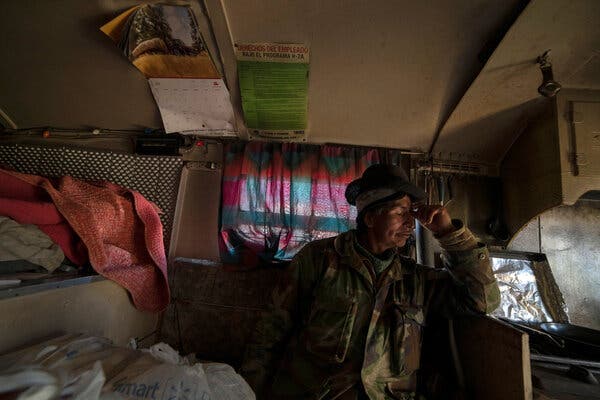
Mr. Mendoza has outfitted his camper with turquoise-and-fuchsia drapes, racks to hang pots and colored strings of light bulbs.
William Woody for The New York Times
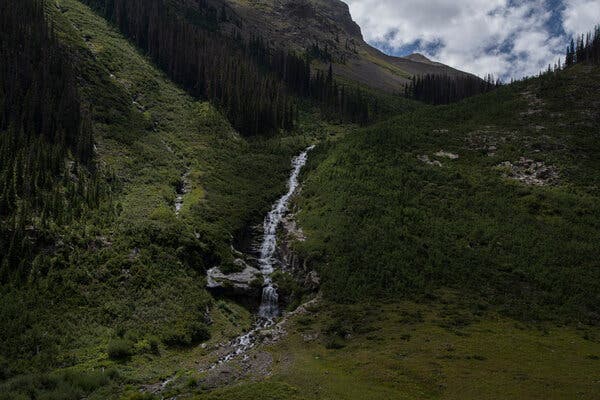
Silver veins of waterfalls stream down the scree rock in the mountains.
William Woody for The New York Times
Eligible for U.S. permanent residency — which current workers on temporary visas are not entitled to by law — many European sheepherders eventually stayed and put down roots in their adopted country. With demand for wool and mutton meat consistently high, they prospered.
The more established nomadic entrepreneurs accumulated vast tracts of land.
As synthetics displaced wool and Americans increasingly showed a predilection for beef, chicken and pork, some were positioned to cash in on Colorado’s budding outdoor-recreation industry.
The Jouflas, from Greece, ran sheep in the Vail Valley, which would become a skiing, rafting, hiking and biking mecca. The Aldasoro brothers, a pair of entrepreneurial siblings from the Basque region, invested in real estate and tourism around Telluride, a one-time mining camp wedged between steep mountains that evolved to attract Hollywood royalty and affluent skiers.
“Some of these families now have entire fiefdoms,” said Andrew Gulliford, author of “The Woolly West.” “They have become well-heeled landed gentry, exactly in remote parts of the American West on land nobody wanted.”
Some, like the Inda family, kept raising sheep. But with a dearth of Americans keen to be herders, ranchers in the 1980s began to recruit workers from Mexico and then South America.
Mr. Mendoza, whose family in Peru owned a few milk cows, sheep and mules, first heard about the sheepherding opportunity from a friend. He traveled to the U.S. embassy in Lima, where he watched a video about being a sheepherder, or borreguero.
He signed his first contract in 2014, sending money to his mother and three children, enabling them to get the schooling that he never got. In the winters, when he is not alone in the mountains, he helps tend to sheep on the Inda family ranch.
He speaks with his family about once a week, depending on whether he can get reception for his cellphone, which he charges with a solar-powered battery. He said that he missed them, and that he longed for papaya, pineapple and quinoa, a Peruvian staple.
But mostly, home is now in the San Juan Mountains, where the silver veins of waterfalls stream down the scree rock, double rainbows adorn the sky, and his family, he said, is his two black-and-white herding dogs, Lacey and Rayo.
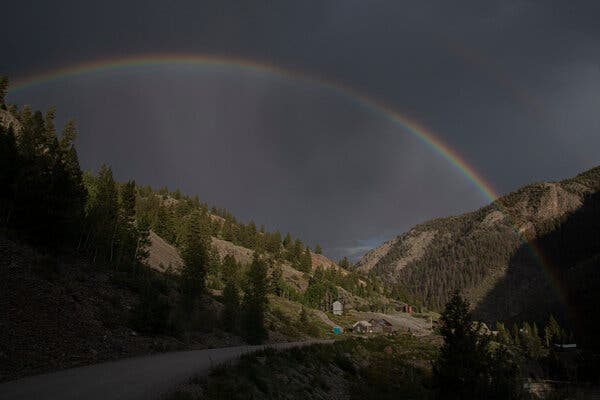
The sheepherder leads a solitary life in the stunning San Juan Mountains, where the sky is often adorned by rainbows.
William Woody for The New York Times
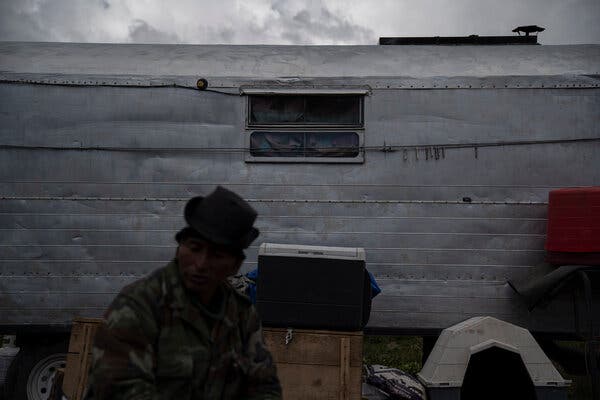
Mr. Mendoza resting outside his camper. Even when he is not with his flock, he said, “It’s the sheep I am thinking about all the time.”
William Woody for The New York Times
“I talk to them as if they were people, and they listen,” he said. “They know me better than anyone. They know my secrets.”
And what is on his mind as he tends to the sheep, day after day, in this Zen landscape?
“It might be hard to understand,” he began, “but it’s the sheep I’m thinking about all the time.”
He endures subfreezing temperatures, hail and snowstorms. Lightning can be terrifying.
But the worst days, he said, are when a band of sheep go astray or come under attack. Despite placing solar-powered lights around his flock at night to fend off predators, a few weeks ago coyotes encroached and killed four lambs.
Mr. Mendoza has been treading some of the same trails as the father and uncles of Dominic Inda, 38, the sheep rancher who is his direct boss. Juan Inda, 77, was the youngest of the three Basque brothers who arrived in Colorado 60 years ago. But unlike them, Mr. Mendoza does not see American citizenship in his future.
People on H-2A visas do not qualify for green cards, the first step toward achieving citizenship. To become permanent residents, sheepherders must be sponsored by their employers, which Mr. Mendoza and other sheepherders say that ranchers are not inclined to do.
“I’ve asked my boss to fix my papers,” he said, referring to immigration status, “but I don’t think it will get done.”
The only sheepherders he knows who eventually got U.S. residency were mojado, or undocumented, he said. They walked off the job, worked illegally elsewhere and eventually married an American, which led to citizenship.
Mr. Inda, who employs six sheepherders on seasonal visas, said he had begun and then interrupted the green card application process for two of them, including Mr. Mendoza, because demand for lambs and wool has declined.
“It’s been a hard year, and it’s hard to do the stuff I’ve got to do with the lawyer,” he said.
In his years abroad, Mr. Mendoza has missed the formative years of his three sons. A green card would allow him to visit Peru for holidays, family celebrations and funerals, he said.
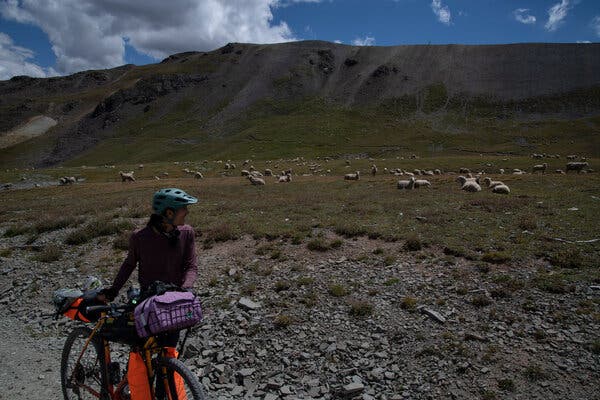
In the rugged, remote Colorado Rockies, sheep are raised for wool and meat. William Woody for The New York Times
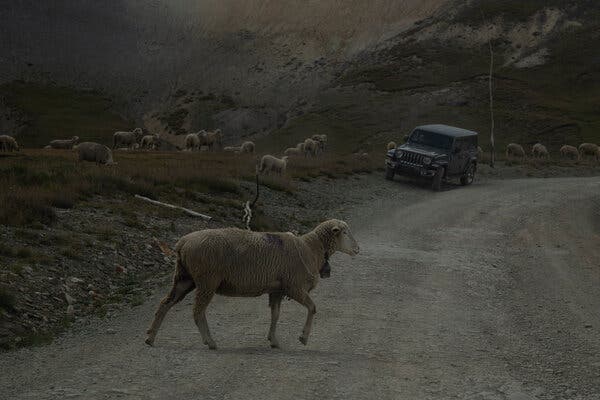
The American sheep industry depends on herders, mostly from Peru, who are brought to America with temporary visas.
William Woody for The New York Times
As in previous years, Mr. Mendoza ventured out in the spring to climb the mountains, making several stops in pastures where his bosses had federal permits for the flock to graze.
He lived in a white canvas tent much of the time, and last month reached the high-alpine basin where Mr. Inda had delivered the tin-sided trailer, near Engineer Pass, about 100 miles from where Mr. Mendoza began.
The camper was cozy, if dingy. He had outfitted it himself, Mr. Mendoza said proudly, with turquoise-and-fuchsia drapes, racks to hang pots and colored strings of light bulbs.
On a pullout table were bags with provisions that Mr. Inda had delivered: chicken breasts, tilapia fillets and ewe meat, which he stored in a cooler, and evaporated milk, butter, cilantro, iced tea and red vinegar.
A frying pan sat atop a gas-fueled burner. An aluminum tray was ideal for baking meat in his wood-fire stove, he said, which doubled as a heater.
He raised his thin mattress on a platform to reveal a collection of music CDs and movies dubbed into Spanish, including “Snitch,” a 2013 thriller starring Dwayne Johnson. He said he sometimes watched movies and listened to music at night — when the sheep were counting sheep, so to speak.
He can often go weeks without seeing anyone. But now, way above the tree line, he could spot another flock in the distance and the white tent of a friend whom Mr. Mendoza said he looked forward to seeing in a few days. They would exchange stories of encounters with bears and coyotes and other mishaps.
Each year, around the time the first snowflakes dust the meadows, Mr. Mendoza leads the sheep down the mountain to the ranch, where they are sheared and mated, giving birth before heading to pasture again.
But on a recent afternoon, he was still guiding the flock from one pasture to another with Lacey and Rayo. As they barked and scampered, sitting sheep rose to their feet and soon the flock clustered, moving in unison.
Later, Mr. Mendoza trudged up the mountain to search for scattered sheep. In a flash, he was on a ridge, rifle resting on his shoulders, binoculars dangling from his neck. His slight frame was but a speck in the vastness, the dogs at his feet.
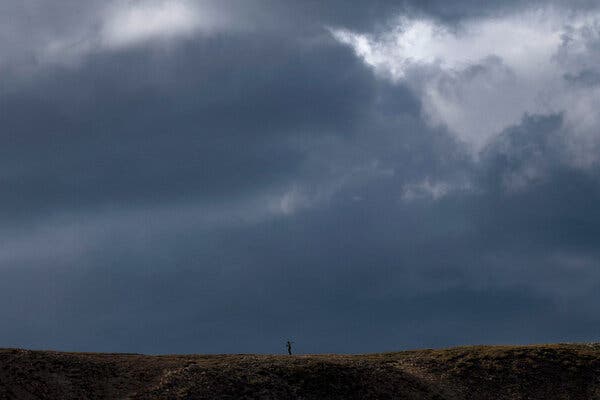
Mr. Mendoza, with his high-powered rifle, searching for lost sheep.
William Woody for The New York Times
